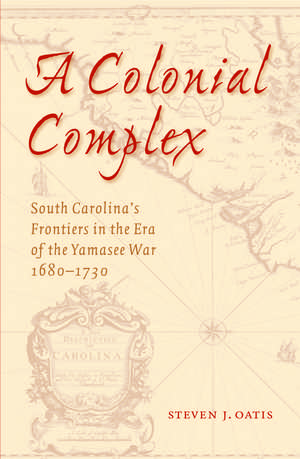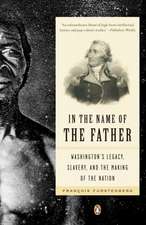A Colonial Complex: South Carolina's Frontiers in the Era of the Yamasee War, 1680-1730
Autor Steven J. Oatisen Limba Engleză Paperback – dec 2008
In 1715 the upstart British colony of South Carolina was nearly destroyed in an unexpected conflict with many of its Indian neighbors, most notably the Yamasees, a group whose sovereignty had become increasingly threatened. The South Carolina militia retaliated repeatedly until, by 1717, the Yamasees were nearly annihilated, and their survivors fled to Spanish Florida. The war not only sent shock waves throughout South Carolina's government, economy, and society, but also had a profound impact on colonial and Indian cultures from the Atlantic Coast to the Mississippi River.
Drawing on a diverse range of colonial records, A Colonial Complex builds on recent developments in frontier history and depicts the Yamasee War as part of a colonial complex: a broad pattern of exchange that linked the Southeast’s Indian, African, and European cultures throughout the late seventeenth and early eighteenth centuries. In the first detailed study of this crucial conflict, Steven J. Oatis shows the effects of South Carolina’s aggressive imperial expansion on the issues of frontier trade, combat, and diplomacy, viewing them not only from the perspective of English South Carolinians but also from that of the societies that dealt with the South Carolinians both directly and indirectly. Readers will find new information on the deerskin trade, the Indian slave trade, imperial rivalry, frontier military strategy, and the major transformations in the cultural landscape of the early colonial Southeast.
Preț: 224.66 lei
Nou
Puncte Express: 337
Preț estimativ în valută:
42.99€ • 44.88$ • 35.58£
42.99€ • 44.88$ • 35.58£
Carte tipărită la comandă
Livrare economică 04-18 aprilie
Preluare comenzi: 021 569.72.76
Specificații
ISBN-13: 9780803220720
ISBN-10: 0803220723
Pagini: 399
Dimensiuni: 152 x 229 x 15 mm
Greutate: 0.61 kg
Editura: Nebraska Paperback
Colecția University of Nebraska Press
Locul publicării:United States
ISBN-10: 0803220723
Pagini: 399
Dimensiuni: 152 x 229 x 15 mm
Greutate: 0.61 kg
Editura: Nebraska Paperback
Colecția University of Nebraska Press
Locul publicării:United States
Notă biografică
Steven J. Oatis is an assistant professor of history at the University of the Ozarks.
Recenzii
"Steven J. Oatis's book is the most important contribution to our understanding of the Yamasee War since Verner Crane's magisterial The Southern Frontier. . . . first published in 1928. . . . Oatis makes it abundantly clear that whatever the causes of the Yamasee War, it powerfully reordered the political landscape of the lower South for a very long time to come."—Charles Hudson, American Historical Review
“This well-written volume will appeal to scholars of the American frontier and the early American South. It effectively draws upon a wide range of English and Spanish sources to provide by far the most detailed account of the war and the events that surrounded it, and readers will appreciate its insights.”—Andrew K. Frank, Itinerario
"A welcome addition to the growing body of literature addressing the early colonial period in the American southwest."—William Wall, Journal of Military History
"With the publication of Steven J. Oatis's excellent book, we finally have a comprehensive and persuasive interpretation of this critical war."—Journal of Southern History
“Oatis allows the reader to appreciate the 'kaleidoscopic complexity' of the eighteenth-century southern frontier with its 'fluid identities and ambiguous alliances'. . . . Oatis has produced a work that is a must read for serious students of South Carolina’s early history.”—Mary Ferrari, South Carolina Historical Magazine
"A Colonial Complex is noteworthy because Oatis provides an insightful look into a conflict that is usually only mentioned as a side note in the history of the Creek Indians. But Oatis's research goes well beyond the Yamasee War, and as a result anyone studying colonial interaction with Indians in the Southeast will find this book useful."—Michael Hoekstra, Southern Historian
A Colonial Complex: South Carolina's Frontiers in the Era of the Yamasee War, 1680-1730. By Steven J. Oatis. Lincoln: University of Nebraska Press, 2004. Pp. xii, 399. Map. Notes. Bibliography. Index. $65.00 cloth.
This important book reexamines the English and Indian Southeast during the crucial half century from 1680 to 1730, a period dominated by the Yamasee War (1715-1717). This was a conflict with a white mortality rate nearly double that of King Philip's War, and "engulfed not just a colony but an entire region . . . [with] three imperial powers and dozens of different Indian societies" (p. 305).
In an intelligent discussion of frontier historiography, Oatis argues that the New Western History, which rejects Frederick Jackson Turner's frontier thesis to emphasize a methodology of "region-making," is too extreme in its dismissal of frontier processes as a transitional state on the way to a mature society. While recognizing regionalist Alan Gallay's study of The Indian Slave Trade (2002) as "the first comprehensive study of the Southeast in the late seventeenth and early eighteenth centuries since Crane's Southern Frontier" (p. 5), Oatis is more attuned to the New Indian History, which has redefined the term "frontier" and brought into focus the dynamics of cultural interaction in a region of multiple societies, none exercising a monopoly of violence. Jack Forbes's concept of a "frontier complex" seems to make the best of both new methodologies.
Most modern historians put the blame for the Yamasee War on the abusive practices of the Indian traders. This is the reason that the proprietors chose to emphasize, although Oatis is attentive to other causes, such as: the Yamasees' declining numbers; the encroachment of white men onto the Port Royal reservation, threatening ten villages; the diminishing supplies of deer for the deerskin trade and of Florida mission Indians for the slave trade; and the Yamasees' growing conviction that the census-taking, fort-constructing, captive-buying government of South Carolina, which had already used the Shawnees to destroy the Westos, had ulterior designs on them. Apalachicolas on the Savannah River and Ocheses on the Ocmulgee River agreed that something must be done, but it was the Yamasees who dealt the first blow, attacking an embassy of South Carolinians at the head town of Pocotaligo, and then sending two war parties against nearby white settlements. As the conflagration spread, neither whites nor Indians presented a united front. While the Catawbas eventually sided with the Yamasees, the Cherokees came to the relief of South Carolina with more men than either Virginia and North Carolina elected to provide. Receiving the first reports of violence, South Carolinians imagined that the Spanish or French were behind it, but the war caught officials in St. Augustine, Pensacola, and Mobile by surprise, and they were clearly unprepared to deal with the fallout of Yamasee refugees at their gates and western Muskogeans at their trading posts, who appeared unannounced to trade their deerskins for guns and rum.
The Yamasee War remade the Southeast's settlement patterns, as native groups abandoned the coast between the Altamaha and Savannah rivers to rebuild their towns, with ditches and palisades, in safer river valleys. The war also furthered the process of ethnogenesis, as fragmented groups combined into new confederacies. Moreover, it checked South Carolina's "imperial offensive" long enough to allow the French to build Fort Toulouse in what would become Alabama, the Spanish to rebuild Fort San Marcos in the crook of Florida, and a new group of British colonists to settle Georgia. And, the author argues, the sheer unexpectedness of the attacks left the South Carolinians with a deep fear of slave insurrections.
Oatis's writing skills, powers of analysis, and command of the South Carolina materials are impressive, but A Colonial Complex tills a fenced field, advancing our knowledge of Southeastern history and ethnohistory to the edge of only one set of sources. The sections on Florida, a colony with its own history of Yamasee settlements, raids, and refugees, are weak; and while the author makes a conscious effort to interpret the behavior of the Yamasees and their allies from an Indian point of view, his stance toward the Spanish and their native allies shows that, even in this fine study, the old divides endure. The Southeast's archives—English, Spanish, and French—hold the scripts of three concurrent dramas, and for the Indian players, an exit from one stage was often an entrance onto another. The first historian to consult all the available documents will be the first to write a history that is truly Indian-centered, instead of yet another history of a subset of white men.
Most modern historians put the blame for the Yamasee War on the abusive practices of the Indian traders. This is the reason that the proprietors chose to emphasize, although Oatis is attentive to other causes, such as: the Yamasees' declining numbers; the encroachment of white men onto the Port Royal reservation, threatening ten villages; the diminishing supplies of deer for the deerskin trade and of Florida mission Indians for the slave trade; and the Yamasees' growing conviction that the census-taking, fort-constructing, captive-buying government of South Carolina, which had already used the Shawnees to destroy the Westos, had ulterior designs on them. Apalachicolas on the Savannah River and Ocheses on the Ocmulgee River agreed that something must be done, but it was the Yamasees who dealt the first blow, attacking an embassy of South Carolinians at the head town of Pocotaligo, and then sending two war parties against nearby white settlements. As the conflagration spread, neither whites nor Indians presented a united front. While the Catawbas eventually sided with the Yamasees, the Cherokees came to the relief of South Carolina with more men than either Virginia and North Carolina elected to provide. Receiving the first reports of violence, South Carolinians imagined that the Spanish or French were behind it, but the war caught officials in St. Augustine, Pensacola, and Mobile by surprise, and they were clearly unprepared to deal with the fallout of Yamasee refugees at their gates and western Muskogeans at their trading posts, who appeared unannounced to trade their deerskins for guns and rum.
The Yamasee War remade the Southeast's settlement patterns, as native groups abandoned the coast between the Altamaha and Savannah rivers to rebuild their towns, with ditches and palisades, in safer river valleys. The war also furthered the process of ethnogenesis, as fragmented groups combined into new confederacies. Moreover, it checked South Carolina's "imperial offensive" long enough to allow the French to build Fort Toulouse in what would become Alabama, the Spanish to rebuild Fort San Marcos in the crook of Florida, and a new group of British colonists to settle Georgia. And, the author argues, the sheer unexpectedness of the attacks left the South Carolinians with a deep fear of slave insurrections.
Oatis's writing skills, powers of analysis, and command of the South Carolina materials are impressive, but A Colonial Complex tills a fenced field, advancing our knowledge of Southeastern history and ethnohistory to the edge of only one set of sources. The sections on Florida, a colony with its own history of Yamasee settlements, raids, and refugees, are weak; and while the author makes a conscious effort to interpret the behavior of the Yamasees and their allies from an Indian point of view, his stance toward the Spanish and their native allies shows that, even in this fine study, the old divides endure. The Southeast's archives—English, Spanish, and French—hold the scripts of three concurrent dramas, and for the Indian players, an exit from one stage was often an entrance onto another. The first historian to consult all the available documents will be the first to write a history that is truly Indian-centered, instead of yet another history of a subset of white men.
"Steven J. Oatis has written a superb account and analysis of the Yamasee War, an event that most historians either simplify or forget but one that had repercussions for all empires, native and foreign, interested in the Southeast. . . . A Colonial Complex will surely rank as a classic text in the study of the colonial South for years to come."—Julie Anne Sweet, The Georgia Historical Quarterly
A Colonial Complex: South Carolina’s Frontiers in the Era of the Yamasee War, 1680–1730. By STEVEN J. OATIS. Lincoln: University of Nebraska Press, 2004. 399 pages. $65.00 (cloth).
Reviewed by L. H. Roper, State University of New York at New Paltz
Steven J. Oatis situates the colonial Southeast within a “frontier complex” (7) of engagements between Indian and European societies. Here, the frontier generated mixed results for “South Carolina imperialists” (43) and the Indians, Africans, and Europeans with whom they came into contact on their quest “to expand their influence over the unsettled areas of their perceived domain” (11). These consequences included the Yamasee War, the region’s counterpart to King Philip’s War.
Oatis bookends his account with the collapse of the Spanish mission system north of Saint Augustine and the appointment of Robert Johnson as governor of South Carolina. During this half century, harried officials in Louisiana, Florida, and Virginia labored to block the expansion efforts of their Carolina neighbors. At the same time, the Carolinians used their indigenous connections, especially with the Yamasee, to create a defensive “buffer zone” (83) for their province. Elsewhere in the region, factions within Lower Creek, Cherokee, Catawba, Chickasaw, and other Indian communities played the Europeans against each other to gain political and economic advantage.
After 1713 the situation of the Yamasee became critical. Oatis cites well-known contributions to their decline, including the trade deficit they created with South Carolina traders, alcohol consumption, and the “abusive” behavior of the “arrogant” (116) Carolinians. These phenomena, though, constituted “the tip of the proverbial iceberg” (116). The southerly push of low-country settlement after Queen Anne’s War severely disrupted the Yamasee economy and compelled the Indians either to turn to slave catching as the chief means of repaying their debts or to face the prospect of enslavement themselves. Anticipating no satisfaction from the South Carolina government, they attacked the colony in April 1715. Ultimately involving the Creek and other Indians, backed by whatever support the Spanish could offer, the war devastated South Carolina, driving the beleaguered survivors to Charles Town.
By 1717, thanks largely to intervention by the Cherokee, most of South Carolina’s enemies had withdrawn south, though they kept the province on edge for another decade. During this period the colony’s government sought to rebuild its relationships with its Indian neighbors. It also made repeated efforts to restore the “pax Caroliniana” (252) that purportedly existed before the outbreak of the war.
The carrot-and-stick methods that these missions employed reflected the deeper changes that had occurred on South Carolina’s frontiers as a consequence of the war. The uprising shocked white Carolinians out of their arrogance and compelled them to seek relief, first from their colonial neighbors and, later, from the Crown after they rebelled against the colony’s lords proprietors in 1719. They also had to resolve anxieties created by the necessity of arming blacks during the emergency. These concerns combined to shift the South Carolinians from “their old brand of semiautonomous imperialism” to a position “closer to the mainstream of the British Empire between 1715 and 1720” (166).
On the other hand, the Cherokee found themselves having to endure the insolence of their Carolina allies after Virginia traders shifted their attentions northward and as they suffered continuing pressure from their old enemies, the Lower Creek, who had sided against them in the war. Even so, these peoples, as well as the Chickasaws and others, remained able to keep the Carolinians at arm’s length.
In the end, despite “all of the significant frontier transformations brought on by new trade networks, new weapons, new alliances, and new colonial settlements, most groups of people in the Southeast managed to maintain at least some hold over the traits and beliefs that distinguished them from other groups” (308). Moreover, when “the dynamics of the exchange process” broke down, “all these cultures chose to fight in order to make themselves understood”: the Yamasee War’s “greatest significance—one that can be applied to the entire southeastern frontier complex—was as a collection of tragic but temporarily effective forms of expression” (310).
Much of this history should be unsurprising to students of the colonial Southeast. From the work of scholars such as James H. Merrell and James Axtell, historians have known for some time of the efforts of the region’s Indians to deal with the new world generated by the arrival of the English. The “new Indian history” (6), as Oatis notes, has substantially revised the classic account of the Southern frontier by Verner W. Crane. Scholars also have considerable familiarity with the character and influence of the Yamasee War thanks to the contributions of Axtell, Alan Gallay, Tom Hatley, Merrell, and others.1 Despite having conducted substantial research, though, Oatis neither engages this literature—except to regard Gallay’s treatment as unsatisfactory—nor compares his Southeast with other early American frontiers.
Oatis’s contention that the frontier “remains the best and most concise way to express a historical process of profound importance to early America in general and to the colonial Southeast in particular” (6) remains unexplained, which calls into question its utility as a framework for understanding the early American past. The case of South Carolina constitutes a particularly shaky foundation on which to rest the historiographical case for the frontier’s significance. Though the English settlers who founded the colony immediately set to work cultivating ties and fomenting a cycle of war and enslavement with their indigenous neighbors, they maintained a Janus-faced perspective in their quest for political and economic advancement, pursuing patronage in the metropolis with the same vigor with which they sought connections among the Indians.
Moreover, it is problematic to characterize the Carolinians as imperialists, a term that Oatis applies to a range of incommensurate actors from trader-politician Thomas Nairne to veteran colonial administrator Sir Francis Nicholson. “Trader-imperialists” (68) neither advocated nor planned the expansion of South Carolina or of the British Empire except when it suited their more immediate and pecuniary aims. Indeed, when settlement, such as at Stuart’s Town, threatened their interests, they moved quickly against it. Oatis’s analysis, then, misses the crux of the province’s politics as evidenced by his claim that necessary reform of the Indian trade had to come from Charles Town; in reality, the traders in Indians habitually controlled the South Carolina government prior to 1721.
Ironically, the Yamasee War, which by all accounts their abuses caused, deflated the longstanding preeminence of Johnson and his cohort of Indian slavers, known as the “Goose Creek men,” in South Carolina and reduced the economic importance of the frontier to the province. Yet, though Oatis notes that the tumultuous politics of South Carolina gave way to a celebrated harmony after 1730, he expresses remarkable reluctance to accept the verdict against the traders, preferring to blame the war and the problems of the Southeast “frontier complex” generally on economic “tensions” (104). Scholars should not acquit the dealers in Indians so readily.
1 James H. Merrell, The Indians’ New World: Catawbas and Their Neighbors from European Contact through the Era of Removal (Chapel Hill, N.C., 1989); Tom Hatley, The Dividing Paths: Cherokees and South Carolinians through the Era of Revolution (New York, 1993); James Axtell, The Indians’ New South: Cultural Change in the Colonial Southeast (Baton Rouge, LA, 1997); Alan Gallay, The Indian Slave Trade: The Rise of the English Empire in the American South, 1670–1717 (New Haven, Conn., 2002).
“While the broad outlines of the Yamasee conflict are well known, Oatis’ exploration of the conflict and the years leading up to and after the war are the best I have read. . . . Rather than casting the war as a turning point in the history of the English South, Oatis deftly reveals how it ended some peoples’ ability to shape their own destinies but, at the same time, it did little to change the imperatives, strategies, and practices that characterized politics and diplomacy in the region. The book is a welcome addition to the recent spate of frontier studies for its subject matter, and Oatis’ rehabilitation of the concept of frontier offers interesting theoretical challenges to studies that have focused instead on region-making and borderlands.”—James Taylor Carson, Southern Quarterly







